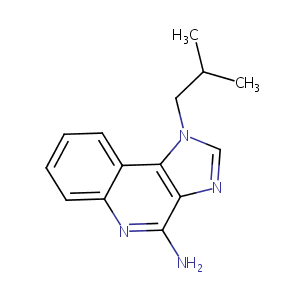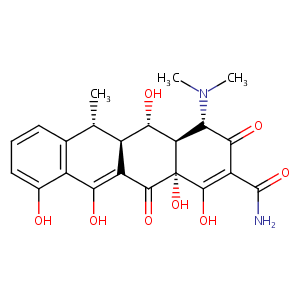| 1 |
ClinicalTrials.gov (NCT03116659) CTCL Directed Therapy
|
| 2 |
Imiquimod FDA Label
|
| 3 |
URL: http://www.guidetopharmacology.org Nucleic Acids Res. 2015 Oct 12. pii: gkv1037. The IUPHAR/BPS Guide to PHARMACOLOGY in 2016: towards curated quantitative interactions between 1300 protein targets and 6000 ligands. (Ligand id: 5003).
|
| 4 |
Doxycycline FDA Label
|
| 5 |
URL: http://www.guidetopharmacology.org Nucleic Acids Res. 2015 Oct 12. pii: gkv1037. The IUPHAR/BPS Guide to PHARMACOLOGY in 2016: towards curated quantitative interactions between 1300 protein targets and 6000 ligands. (Ligand id: 6464).
|
| 6 |
ClinicalTrials.gov (NCT00764361) Safety Study of Topical Doxycycline Gel for Adult Diabetic Lower Extremity Ulcers. U.S. National Institutes of Health.
|
| 7 |
Imiquimod enhances IFN-gamma production and effector function of T cells infiltrating human squamous cell carcinomas of the skin. J Invest Dermatol. 2009 Nov;129(11):2676-85.
|
| 8 |
Summary of information on human CYP enzymes: human P450 metabolism data. Drug Metab Rev. 2002 Feb-May;34(1-2):83-448.
|
| 9 |
The Toll-like receptor agonist imiquimod is metabolized by aryl hydrocarbon receptor-regulated cytochrome P450 enzymes in human keratinocytes and mouse liver. Arch Toxicol. 2019 Jul;93(7):1917-1926.
|
| 10 |
Cannabidiol selectively modulates interleukin (IL)-1 and IL-6 production in toll-like receptor activated human peripheral blood monocytes. Toxicology. 2021 Dec;464:153016. doi: 10.1016/j.tox.2021.153016. Epub 2021 Nov 2.
|
| 11 |
(9)-Tetrahydrocannabinol Suppresses Monocyte-Mediated Astrocyte Production of Monocyte Chemoattractant Protein 1 and Interleukin-6 in a Toll-Like Receptor 7-Stimulated Human Coculture. J Pharmacol Exp Ther. 2019 Oct;371(1):191-201. doi: 10.1124/jpet.119.260661. Epub 2019 Aug 5.
|
| 12 |
Imiquimod: a potential weapon against Dupuytren contracture. Med Hypotheses. 2006;66(5):991-2. doi: 10.1016/j.mehy.2005.09.052. Epub 2005 Dec 20.
|
| 13 |
Imiquimod induces apoptosis of human melanocytes. Arch Dermatol Res. 2010 May;302(4):301-6. doi: 10.1007/s00403-009-1012-0. Epub 2009 Dec 23.
|
| 14 |
Effect of toll-like receptor 7 and 9 targeted therapy to prevent the development of hepatocellular carcinoma. Liver Int. 2015 Mar;35(3):1063-76. doi: 10.1111/liv.12626. Epub 2014 Jul 30.
|
| 15 |
Tumor-selective induction of apoptosis and the small-molecule immune response modifier imiquimod. J Natl Cancer Inst. 2003 Aug 6;95(15):1138-49. doi: 10.1093/jnci/djg016.
|
| 16 |
Aryl hydrocarbon receptor protects lung adenocarcinoma cells against cigarette sidestream smoke particulates-induced oxidative stress. Toxicol Appl Pharmacol. 2012 Mar 15;259(3):293-301.
|
| 17 |
Drugs@FDA. U.S. Food and Drug Administration. U.S. Department of Health & Human Services.
|
| 18 |
Mammalian drug efflux transporters of the ATP binding cassette (ABC) family in multidrug resistance: A review of the past decade. Cancer Lett. 2016 Jan 1;370(1):153-64.
|
| 19 |
A further interaction study of quinine with clinically important drugs by human liver microsomes: determinations of inhibition constant (Ki) and type of inhibition. Eur J Drug Metab Pharmacokinet. 1999 Jul-Sep;24(3):272-8.
|
| 20 |
Functional and histochemical analysis of MDR3 P-glycoprotein in a tetracycline-controlled gene expression system. Eur J Med Res. 2000 Dec 29;5(12):517-22.
|
| 21 |
Systems pharmacological analysis of drugs inducing stevens-johnson syndrome and toxic epidermal necrolysis. Chem Res Toxicol. 2015 May 18;28(5):927-34. doi: 10.1021/tx5005248. Epub 2015 Apr 3.
|
| 22 |
Synthesis and in vitro evaluation of targeted tetracycline derivatives: effects on inhibition of matrix metalloproteinases. Bioorg Med Chem. 2007 Mar 15;15(6):2368-74. doi: 10.1016/j.bmc.2007.01.026. Epub 2007 Jan 19.
|
| 23 |
Chloramphenicol causes mitochondrial stress, decreases ATP biosynthesis, induces matrix metalloproteinase-13 expression, and solid-tumor cell invasion. Toxicol Sci. 2010 Jul;116(1):140-50. doi: 10.1093/toxsci/kfq085. Epub 2010 Mar 25.
|
| 24 |
A high-content screen identifies novel compounds that inhibit stress-induced TDP-43 cellular aggregation and associated cytotoxicity. J Biomol Screen. 2014 Jan;19(1):44-56. doi: 10.1177/1087057113501553. Epub 2013 Sep 9.
|
|
|
|
|
|
|


